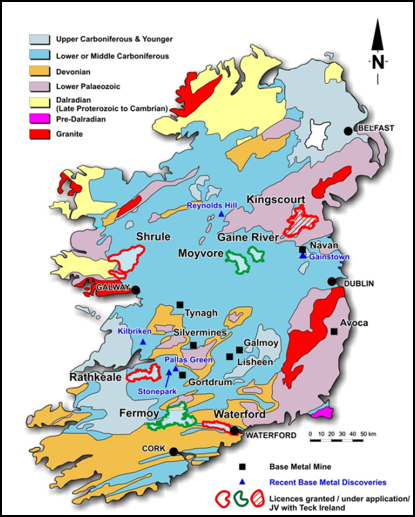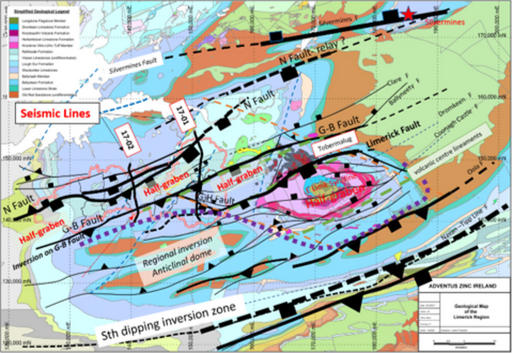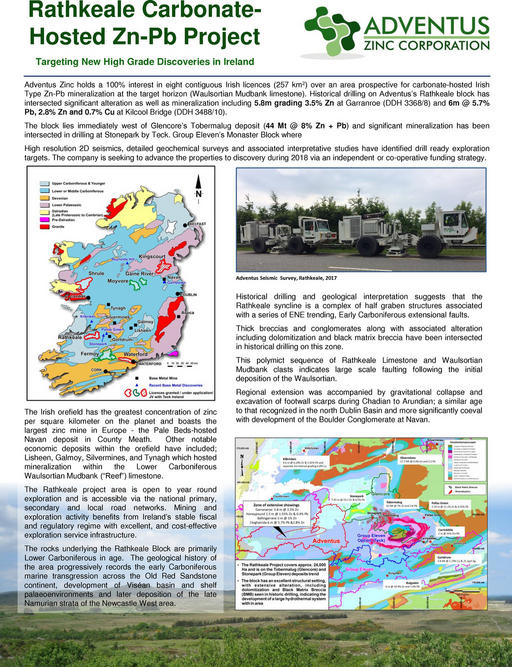- Home
- Corporate
- About Us
- Management
- Board of Directors
- Strategic Shareholders
- Mission, Vision, and Values
- Corporate Governance
- Projects
- Overview
- Why Ecuador
- Ecuador
- El Domo – Curipamba
- Condor
- Pijili
- Santiago
- Tres Picachos
- Tarqui
- Quimi
- Chalapo
- La Canela
- Orquideas
- Cascas
- Pegasus
- Ireland
- Exploration Alliance
- Equity Holdings
- Investors
- Stock information
- Company Presentation
- Financial Statements
- ESTMA
- Strategic Shareholders
- Environment & Community
- Annual General Meeting
- News

Ireland
Rathkeale
Adventus holds a 100% interest in eight contiguous Irish licences (257 km2) over an area prospective for carbonate-hosted Irish Type Zn-Pb mineralization at the target horizon (Waulsortian Mudbank limestone). Historical drilling on Adventus’s Rathkeale block has intersected significant alteration as well as mineralization including 5.8m grading 3.5% Zn at Garranroe (DDH 3368/8) and 6m @ 5.7% Pb, 2.8% Zn and 0.7% Cu at Kilcool Bridge (DDH 3488/10).
The block lies immediately west of Glencore’s Tobermalug deposit (44 Mt @ 8% Zn + Pb) and significant mineralization has been intersected in drilling at Stonepark by Teck. Group Eleven’s Monaster Block where
High resolution 2D seismics, detailed geochemical surveys and associated interpretative studies have identified drill ready exploration targets. The company is seeking to advance the properties to discovery during 2018 via an independent or co-operative funding strategy.
Historical drilling and geological interpretation suggests that the Rathkeale syncline is a complex of half graben structures associated with a series of ENE trending, Early Carboniferous extensional faults.
Thick breccias and conglomerates along with associated alteration including dolomitization and black matrix breccia have been intersected in historical drilling on this zone.
This polymict sequence of Rathkeale Limestone and Waulsortian Mudbank clasts indicates large scale faulting following the initial deposition of the Waulsortian.
Regional extension was accompanied by gravitational collapse and excavation of footwall scarps during Chadian to Arundian; a similar age to that recognized in the north Dublin Basin and more significantly coeval with development of the Boulder Conglomerate at Navan.
The Irish orefield has the greatest concentration of zinc per square kilometer on the planet and boasts the largest zinc mine in Europe – the Pale Beds-hosted Navan deposit in County Meath. Other notable economic deposits within the orefield have included; Lisheen, Galmoy, Silvermines, and Tynagh which hosted mineralization within the Lower Carboniferous Waulsortian Mudbank (“Reef”) limestone.
The Rathkeale project area is open to year round exploration and is accessible via the national primary, secondary and local road networks. Mining and exploration activity benefits from Ireland’s stable fiscal and regulatory regime with excellent, and cost-effective exploration service infrastructure.
The rocks underlying the Rathkeale Block are primarily Lower Carboniferous in age. The geological history of the area progressively records the early Carboniferous marine transgression across the Old Red Sandstone continent, development of Viséan basin and shelf palaeo environments and later deposition of the late Namurian strata of the Newcastle West area.
Key Elements to Prospectivity of the Rathkeale Block
- Along strike from highly significant mineralization at Tobermalug (Glencore) and Stonepark (Group Eleven, former Teck)
- Complex geology with well developed host lithologies
- Several prospects at which mineralization has been detected (Ballyfookoon, Honeypound, Hollywood House, Ballingarrane, Kilcool Bridge and Cooltomin)
- Excellent structural setting with thick breccias developed at various locations at the margins of the Rathkeale Syncline
- These are interpreted to be debris flow deposits on a fault scarp marking a complex half-graben which was active during the Chadian/Arundian, a time considered critical to mineralization in the Irish Orefield
- Extensive alteration, including dolomitisation and Black Matrix Breccias in historical drilling, indicates the development of a large hydrothermal system within the area
- Deeply excavating structures marked by conglomerates and breccia flows capable of tapping deep seated basement fluids and also act as draw down conduits for connate fluids
- Main focus of recent exploration by previous holders was on the norther margin of the Rathkeale Syncline – other areas the licence block remain relatively underexplored
- A large number of targets identified and work programmes underway
The Rathkeale block has strong potential for the discovery of economic, Irish Type Zn-Pb mineralization and based on initial reviews a two-stage work programme is being pursued with the first phase now completed:
Phase One (2017)
Work programmes focussed around a high resolution 2D seismic survey; including reprocessing and interpretation of historical geological, geophysical and geochemical data for the block. Detailed remote sensing and tecto-stratigraphic studies have also been undertaken to identify key structures. Fieldwork has included;
- Detailed ground magnetics surveying, historical core logging/geochemical & petrophysical sampling, geological mapping and prospecting
- Rock and geochemical characterization studies
- Lithogeochemical and shallow soil sampling
Phase Two (2018)
Phase one activity is considered to have demonstrated the prospectivity of, and identified targets on, the Rathkeale Block.
A radically new structural understanding of the area has been developed through the seismic survey. This revised interpretation has resulted in the identification of several targets in addition to a re-assessment of historical targets. These are being refined through innovative geochemistry surveys to identify zones of potential upfault leakage from concealed massive sulphide.
The seismic has provided a clear targeting strategy, a number of near drill-ready targets and an approach to advance secondary targets towards a drill decision. Diamond drilling is warranted to test the emergent targets.
South 32 Earn-in Agreement
In January 13, 2020, Adventus and South 32 entered and earn-in agreement to advance the exploration of the Rathkeale, Kingscourt and Fermoy projects (See January 13, 2020 news release – link). This was followed by the Irish government approval of this agreement (see April 14, 2020 news release – link).
The Earn-in Agreement grants South32 Base Metals Ireland the right to acquire a 70% interest in the Projects by sole funding EUR 3,500,000 in exploration on the Projects over a four-year period. AZIL will operate the exploration activities during the earn-in period.
On December 3, 2021, drilling started in the Rathkeale block as part of seven targets selected from the initial phase of exploration (see December 3, 2021 news release – link)



